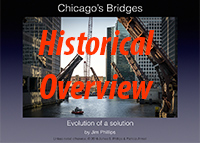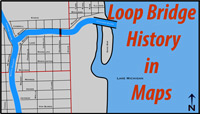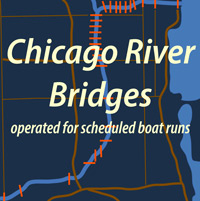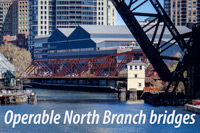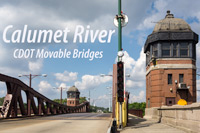N Michigan Ave. bridge - opened May 14, 1920
“The crowds surged against the ropes. The band began 'The Star Spangled Banner.' Then Big Bill's show broke loose. Airplanes over the bridge sending showers of booster literature, boats under the bridge blowing shrill whistles, sirens, calliopes; bombs exploding and sending gay umbrellas and flower designs fluttering down upon the massed heads, confetti and music and flying banners everywhere.” (“HORN TOOTS ITS LOUDEST BLAST AS LINK OPENS”, Chicago Daily Tribune, May 15, 1920)

Du Sable Bridge at Michigan Avenue
Thus read the description of the dedication of the “Link” / Michigan Avenue / DuSable Bridge. It was a big day for Mayor William Hale “Big Bill” Thompson. The bridge he had strongly supported was opening on his 50th birthday.
The notion of linking the boulevard systems on the north and south sides of the river to ease congestion was first discussed in the 1890's. At the turn of the century, planning for the project became more focused and it ultimately became an important part of the 1909 Plan of Chicago. Due to a number of factors, including WWI, construction didn't begin until April of 1918.
Only the upper deck and the two operable bridgehouses, which were steel skeletons covered in plywood, were ready for the opening ceremonies. The lower deck was completed at the end of 1920, followed by the masonry work on the four bridgehouses in 1922. The bas relief panels that adorn each bridgehouse were completed in 1928.
While this bridge was a new crossing, it replaced a long-lived center pier swing bridge at Rush St just west of Michigan Ave. Traffic volume had grown to the point that this old bridge was a major bottleneck for land and water traffic.

Rush St bridge met the north bank of the Chicago River where the Chicago Water Taxi is docked (© 2014 Patricia Armell)
The Michigan Avenue bridge is the second of four double deck trunnion bascule bridges built downtown. It was unique in two respects. Both decks carried vehicular traffic – six lanes of boulevard traffic on the upper deck and four lanes of commercial traffic on the lower deck. What appears to be one large bridge is essentially two smaller bascule bridges side-by-side. The two are tied together to operate as one but can be operated independently if needed.
The lead individuals for the bridge design were: Hugh E. Young, Engineer of Bridge Design, and Thomas G. Pihlfeldt, Engineer of Bridges. Edward H. Bennett was the consulting Architect for the Chicago Plan Commission and William A. Mulcahy was the Chief Engineer in charge of construction. The substructure and steel erection was accomplished by Great Lakes Dredge & Dock Company. The steel was fabricated by the American Bridge Company.
The trunnion bascule is a balanced horizontal seesaw with unequal arms – the longer arm is the bridge leaf over the river, the shorter arm supports the much larger counter weight on the shore. In the case of the Michigan Avenue bridge, the leaf weight is approximately 4,100 tons, while the counter weight is around 12,000 tons. Because it is balanced, only a small amount of external energy is required to raise and lower the bridge. In this case, two 108 hp electric motors and a simple gearing system generates the power necessary to raise each half of the bridge in about a minute (for comparison, an electric Fiat 500e weighs 2,980 pounds and is powered by a 111 hp motor).
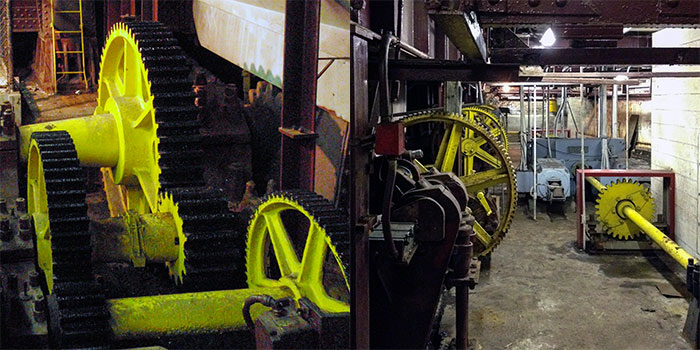
Drive gears (Left) - Heel locks, motors, clutch, and drive shaft (Right) - Inside the McCormick Bridgehouse & Chicago River Museum at the DuSable Bridge
The four neoclassical beaux arts style bridgehouses and its central location make this the most recognizable, and to many the most beautiful, of Chicago's bascules. Functionally, the bridge only needed two bridgehouses for operation (NW and SE corners). The second pair was added to make an architectural statement about the importance of this crossing as a gateway between the north and south sides of the river.
Another architectural consideration for Chicago's downtown bascule bridges was the structural support of the bridge leaves. Architects wanted all structural steel below the deck, allowing a clear view of the surroundings. The “worst” case would be to have all the structural support above the deck, obstructing the view. The two decks of the Michigan Avenue bridge provide a contrast of these two extremes. The upper level is the ideal, the lower level is not. From an engineering perspective, this ideal was not always achievable as an inspection of the bridges along the Main Stem would reveal.
The Michigan Ave bridge has been a workhorse from the beginning. The Chicago Daily Tribune published a photo in its May 17, 1920 edition with the caption:
“Apparently every driver of an automobile made it a point to cross the structure, resulting in an almost continuous jam that that kept the traffic cops hustling.”
The photograph documented traffic on the first Sunday the bridge was open. In its first year of operation, the bridge was operated 3,327 times and it was estimated that each lift stopped about 350 vehicles on both levels.
Different names have been proposed over the life of the iconic bridge. In 1921, the Chicago Historical Society suggested a name change to the “Marquette-Joliet Bridge.” In 1939, the Fort Dearborn memorial committee suggested to the city council that the bridge be named the “Fort Dearborn Bridge.” Both of these naming attempts were unsuccessful. In 2010, after a decade of effort, Friends of DuSable and the DuSable League convinced the city to rename the Michigan Avenue bridge as “DuSable Bridge” after the first non-native settler in the area, making it the seventh downtown bridge to honor a person, institution, or event.
The most dramatic incident in the its ninety four years occurred on September 20, 1992 when one of the bridge leaves became a catapult. The bridge was under rehabilitation with the decking stripped and a forty ton construction crane was on the SE leaf over the counter weight. During a seemingly routine bridge lift only the north leaves were raised for sail boats. As the north leaves were lowered, the SE leaf sprang up sending debris across upper Michigan Ave. The crane fell through the gap between the bridge and the street with the 285 pound ball landing on an occupied car on lower Wacker. The bridge leaf broke off its trunnions and fell into the pit. Thankfully, no one was seriously injured in the incident, including the man sitting in his car.
Engineering forensic studies identified the cause of the accident as a combination of a severely unbalanced bridge leaf and partially disengaged safety locks. This condition allowed the rack and pinion to un-mesh which allowed the leaf to rise uncontrolled. The bridge was reopened to traffic on November 25, 1992.
DuSable Bridge is a defining image of Chicago, whether shown in movies, on television, or in news broadcasts. It is one of the most photographed landmarks in the city. In 2010, it was the end point for the Stanley Cup parade. It also serves as the central landmark for the annual St. Patrick's Day dyeing of the Chicago River and the Magnificent Mile Lights Festival.
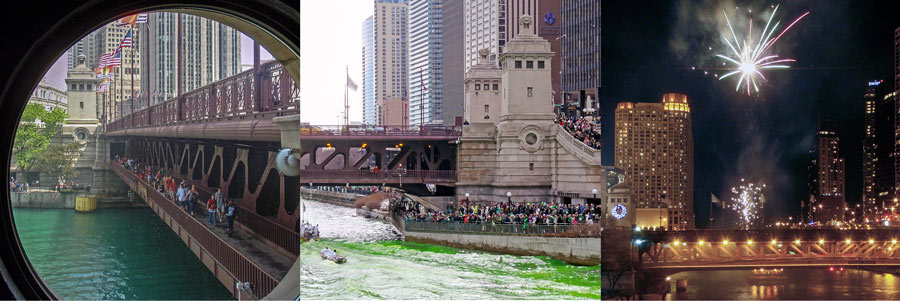
Fans crossing the bridge for the 2010 Stanley Cup parade (Left) - Dyeing the Chicago River green (Center) - Magnificent Mile lights Festival (Right)
While the nature of Chicago River traffic at the DuSable Bridge has changed dramatically over its 95 years, the bridge is operated about fifty times each year for flotillas of migrating sailboats. You can watch the gates come down, see lights flash, hear the bells, watch the gigantic leaves move skyward and wave to the masted vessels as they sail by. It's a joy to see and an opportunity to reflect on Chicago's maritime past.
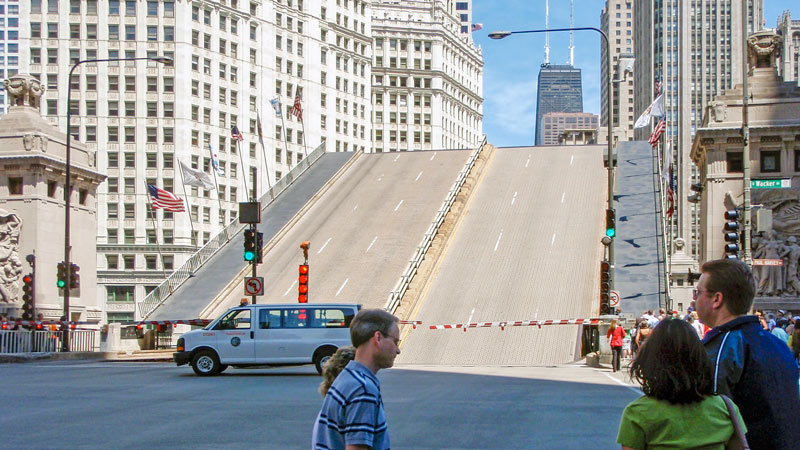
DuSable Bridge going up
Mary Schmich wrote a column entitled “Like the bridge we stand helpless” (Chicago Tribune, September 23, 1992) in response to accident in 1992. As a part of her remarks, she wrote:
“One of the benefits of any infrastructure fiasco is that we get to ask questions like 'Why?' We get a lesson in how things work. We get a peek at the city's skeleton, a chance to apply our 6th-grade knowledge of the laws of physics. We get to toss around words like infrastructure.
Thanks to the Michigan Avenue bridge, we now know about counterweights and drive racks and trunnion pins. Bridges will never look the same.”
In June of 2006, the McCormick Bridgehouse & Chicago River Museum opened in the SW bridgehouse. The museum is maintained and operated by Friends of the Chicago River. It is the best place to learn about the Chicago River and the only place to observe the lifting machinery of a bridge in operation.
Today we can still thank the DuSable Bridge at Michigan Ave and Friends of the Chicago River for teaching us about 6th-grade physics, counterweights, rack and pinion gears, and trunnions. The best part is we don't have to endure the “fiasco” part - just head down to the “Bridgehouse Museum.” To paraphrase Mary Schmich - Chicago's bridges will never look the same.
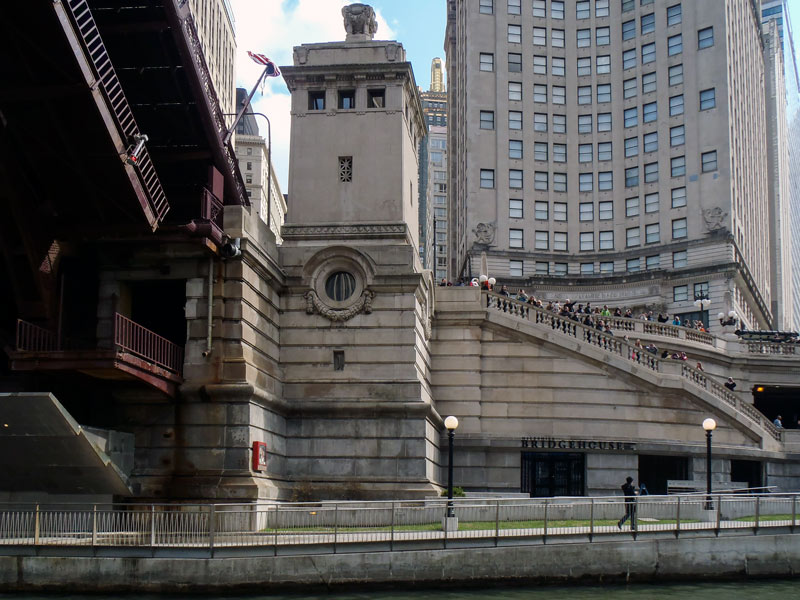
Sailing by the McCormick Bridgehouse & Chicago River Museum
"New" fun fact: The outboard sidewalks on the lower deck were added in 1972.
Note: sources for this article included: A survey of numerous articles from ProQuest Historical Newspapers Chicago Tribune (1849-1985 and 1985-Present); Chicago Sun-Times September 21, 1992; Engineering News Record May 13, 1920; & “Two Miles Eighteen Bridges – A walk along the Chicago River.”

